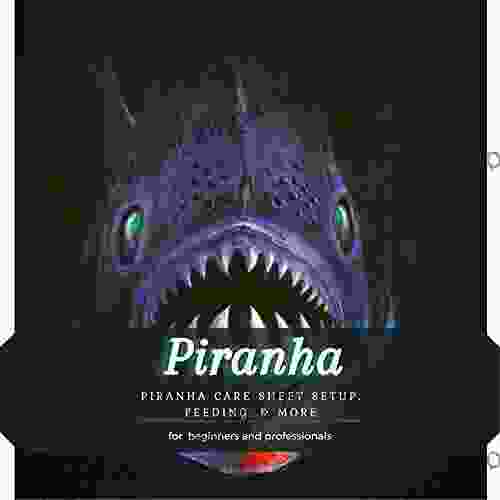Piranha Piranha: An In-Depth Care Sheet for the Enchanting and Intriguing Predator

: Unveiling the Enigmatic Piranha
Piranhas, the formidable and alluring denizens of South America's freshwater ecosystems, captivate the imagination with their razor-sharp teeth and predatory instincts. Their enigmatic nature and captivating presence have garnered both fear and fascination from humans. This comprehensive care sheet delves into the intricacies of piranha care, empowering you with the knowledge and expertise to provide these unique creatures with an optimal and enriching environment.
Taxonomy and Species Overview
The term "piranha" encompasses a diverse group of species belonging to the Characidae family. These fish are further classified into two distinct genera: Serrasalmus and Pygocentrus. The former includes the notorious red-bellied piranha (Serrasalmus nattereri),renowned for its aggressive behavior, while the latter encompasses a more peaceful species, the black piranha (Pygocentrus cariba).
5 out of 5
| Language | : | English |
| File size | : | 757 KB |
| Text-to-Speech | : | Enabled |
| Screen Reader | : | Supported |
| Enhanced typesetting | : | Enabled |
| Print length | : | 15 pages |
| Lending | : | Enabled |
Physical Characteristics and Distinctive Features
Piranhas exhibit a sleek and elongated body shape, adapted for swift and agile movements. Their dorsal fins are adorned with sharp spines used for defense, while their adipose fins, located behind the dorsal fin, serve as a fat reserve. The most striking feature of piranhas is their formidable dentition, featuring two rows of close-set, razor-sharp teeth. This dental apparatus, along with their powerful jaw muscles, allows them to exert immense pressure, enabling them to tear through flesh with remarkable efficiency.
Natural Habitat: Exploring the Our Book Libraryian Waters
Piranhas primarily inhabit the vast river systems and tributaries of the Our Book Library Basin, extending from Colombia and Venezuela in the north to Argentina in the south. They are most commonly found in slow-moving waters with dense vegetation and submerged roots, providing them with ample shelter and hunting grounds. Piranhas prefer warm temperatures ranging from 75 to 85 degrees Fahrenheit (24 to 29 degrees Celsius).
Social Behavior and Territorial Instincts
Piranhas are highly social creatures, forming large shoals that can number in the hundreds or even thousands. Within these shoals, a hierarchical structure exists, with dominant individuals asserting their authority through aggressive displays and physical dominance. Piranhas are fiercely territorial, defending their designated area from other shoals and potential predators.
Dietary Habits: Understanding the Piranha's Predatory Nature
Piranhas are voracious carnivores, their diet primarily consisting of live prey. Small fish, insects, worms, and even larger animals that venture too close to the water's edge are all potential targets. Piranhas employ a distinctive feeding strategy, known as a "piranha frenzy." When a suitable food source is detected, the entire shoal converges on the prey, tearing it apart within seconds.
Aquarium Setup: Creating an Optimal Environment
Providing an appropriate aquarium environment is crucial for the well-being and longevity of piranhas. The minimum tank size recommended for a small group is 120 gallons (454 liters),allowing ample space for swimming and territorial behavior. The water should be maintained at a temperature of 75 to 85 degrees Fahrenheit (24 to 29 degrees Celsius),with a neutral pH of 6.5 to 7.5. Ensure the aquarium has good filtration and ample oxygenation, as piranhas require high water quality. Provide plenty of hiding places using live plants, rocks, and caves.
Feeding Your Piranha: A Balanced and Nutritious Diet
A well-balanced and varied diet is essential for maintaining the health and vitality of piranhas. Live feeders, such as small fish, worms, and crickets, are eagerly consumed by these predators. Frozen or freeze-dried food can also be offered as a supplement. It is crucial to avoid overfeeding, as piranhas can quickly become obese, leading to health issues.
Health and Disease Prevention: Ensuring Well-being
Providing a clean and well-maintained environment is the cornerstone of piranha health. Regular water changes, coupled with proper filtration and oxygenation, help prevent water quality issues that can lead to disease. Piranhas are susceptible to a range of conditions, including bacterial infections, parasites, and fungal diseases. Early detection and veterinary intervention are essential to ensure a prompt recovery.
Reproduction and Breeding Behaviors
Piranhas reach sexual maturity between 12 and 18 months of age. During the breeding season, males exhibit territorial behavior, defending their preferred spawning grounds. Females lay eggs on vegetation or in crevices, and the males guard the eggs until they hatch. The fry are small and vulnerable, initially feeding on zooplankton before transitioning to a carnivorous diet.
Conservation Status: Protecting the Enigmatic Predators
Piranhas play a vital ecological role in their native ecosystems, controlling fish populations and maintaining a balanced food web. However, overfishing and habitat destruction pose threats to their survival. Conservation efforts are underway to protect these fascinating and important species, ensuring their continued existence.
Frequently Asked Questions: Addressing Common Queries
- Are piranhas dangerous to humans? Yes, piranhas can be dangerous, especially when threatened or provoked. However, their reputation for being highly aggressive and attacking humans indiscriminately is exaggerated.
- How large do piranhas grow? Most piranha species grow to a length of 5 to 8 inches (13 to 20 centimeters),with the black piranha being the largest species, reaching up to 12 inches (30 centimeters) in length.
- Can piranhas be kept as pets? While it is possible to keep piranhas in a home aquarium, it requires specialized knowledge, experience, and a deep understanding of their unique needs.
- What is the lifespan of a piranha? In captivity, piranhas can live for 10 to 15 years with proper care.
- Are piranhas schooling fish? Yes, piranhas are highly social creatures and form large shoals in their natural habitat.
: Appreciating the Allure of the Piranha
Piranhas, with their enigmatic and captivating presence, challenge our perceptions of the natural world. Their formidable predatory instincts, complex social behavior, and ecological significance make them fascinating subjects of study. By understanding their unique needs and providing an appropriate environment, we can appreciate the beauty and wonder of these enigmatic creatures. Whether observed in their natural habitat or in the confines of an aquarium, piranhas continue to inspire both awe and respect, reminding us of the incredible biodiversity that our planet holds.
5 out of 5
| Language | : | English |
| File size | : | 757 KB |
| Text-to-Speech | : | Enabled |
| Screen Reader | : | Supported |
| Enhanced typesetting | : | Enabled |
| Print length | : | 15 pages |
| Lending | : | Enabled |
Do you want to contribute by writing guest posts on this blog?
Please contact us and send us a resume of previous articles that you have written.
 Book
Book Novel
Novel Page
Page Chapter
Chapter Text
Text Story
Story Genre
Genre Reader
Reader Library
Library Paperback
Paperback E-book
E-book Magazine
Magazine Newspaper
Newspaper Paragraph
Paragraph Sentence
Sentence Bookmark
Bookmark Shelf
Shelf Glossary
Glossary Bibliography
Bibliography Foreword
Foreword Preface
Preface Synopsis
Synopsis Annotation
Annotation Footnote
Footnote Manuscript
Manuscript Scroll
Scroll Codex
Codex Tome
Tome Bestseller
Bestseller Classics
Classics Library card
Library card Narrative
Narrative Biography
Biography Autobiography
Autobiography Memoir
Memoir Reference
Reference Encyclopedia
Encyclopedia Milton Glaser
Milton Glaser Ted Seides
Ted Seides Robert Kegan
Robert Kegan Violet Ramis Stiel
Violet Ramis Stiel Randall E Stross
Randall E Stross Magoosh
Magoosh Sumner Redstone
Sumner Redstone Philip C Kolin
Philip C Kolin William V Dunning
William V Dunning Tom Basile
Tom Basile Marc Evan Aupiais
Marc Evan Aupiais Marcia Bjornerud
Marcia Bjornerud Vanessa Ogle
Vanessa Ogle Louise Borden
Louise Borden Lon Varnadore
Lon Varnadore Lucee Joie
Lucee Joie Vernisha Parrish
Vernisha Parrish Shing Tung Yau
Shing Tung Yau Lucky Thompson
Lucky Thompson Mark Tatulli
Mark Tatulli
Light bulbAdvertise smarter! Our strategic ad space ensures maximum exposure. Reserve your spot today!
 Jorge Luis BorgesFollow ·4.9k
Jorge Luis BorgesFollow ·4.9k Ernest J. GainesFollow ·7.1k
Ernest J. GainesFollow ·7.1k Henry Wadsworth LongfellowFollow ·17.8k
Henry Wadsworth LongfellowFollow ·17.8k Lucas ReedFollow ·15.3k
Lucas ReedFollow ·15.3k Leon FosterFollow ·15.7k
Leon FosterFollow ·15.7k Russell MitchellFollow ·3.3k
Russell MitchellFollow ·3.3k Demetrius CarterFollow ·2.4k
Demetrius CarterFollow ·2.4k Carlos DrummondFollow ·14.2k
Carlos DrummondFollow ·14.2k

 Truman Capote
Truman CapoteShort, Skinny Mark Tatulli: The Ultimate Guide to a...
Are you tired of being...

 Robert Heinlein
Robert HeinleinEmbark on an Unforgettable Cycling Adventure: The Classic...
Explore the Timeless...

 Bryce Foster
Bryce FosterMisty Twilight: Marguerite Henry's Enduring Masterpiece
A Literary Legacy that...

 Anton Chekhov
Anton ChekhovUnleash the Explosive Power of DC Comics Bombshells 2024...
Prepare yourself for an...

 Juan Butler
Juan ButlerUnleash the Thrill: Discover 'Know Your Rider' by...
Prepare yourself for an...
5 out of 5
| Language | : | English |
| File size | : | 757 KB |
| Text-to-Speech | : | Enabled |
| Screen Reader | : | Supported |
| Enhanced typesetting | : | Enabled |
| Print length | : | 15 pages |
| Lending | : | Enabled |














